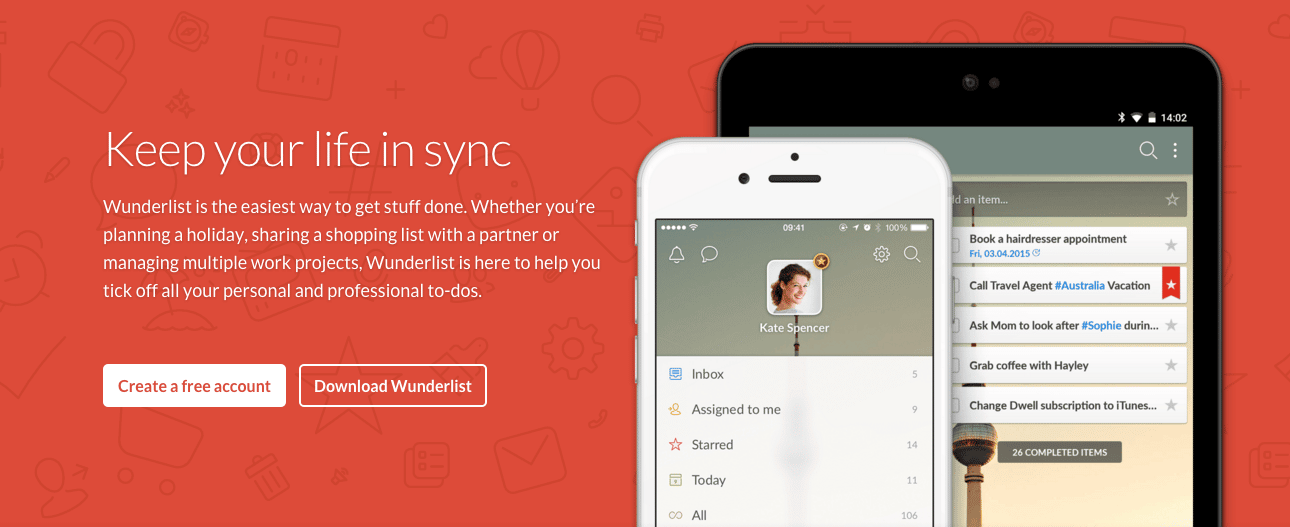Distractions are everywhere – from our mobile phones to social media networks – the heightened skill of “multitasking” is celebrated at many startups as a characteristic of a ‘hard worker’. Yet, a constant challenge I hear from many of my colleagues and clients is, “Suttida, I am being pulled in so many directions and everything is top priority. What should I do?”
Here are a few productivity hacks every startup and/or small business marketer should adopt in order to stay sane, gain momentum with their marketing efforts and take complete control of their to-do list…
Leverage a project management tool
Let’s face it, a lot of the project management tools out there suck and we all just begrudgingly sign up for one because it’s better than resorting to using excel spreadsheets. Truth be told, I’ve tried quite a few and the one that I’ve stuck to is Wunderlist.
With Wunderlist, I have repetitive implementations that remind me every week of what I need to do and I keep track of all of my client projects. I also love their user interface and the fact that they have native apps for both desktop and mobile.
If you’re not sure about where to begin, start with the following before narrowing in on which project management tool you should use:
- Can you get cultural buy-in? Here’s the thing, you’re going to be working with others outside of the marketing department, so find a common point that’s going to benefit everyone.
- Figure out what’s broken with your processes and how you can simplify them.
- How will a project mgmt tool increase collaborative teamwork and accountability?
- Test out at least three different tools before choosing the one that’s best for you. In other words, don’t go for the first one you test drive. I chose Wunderlist because it flows better with my team’s needs and the other tools we looked into felt too cluttered.
Automate as much as you can
Technology is your friend, so use it to your advantage. Look at tools that will help you create drip campaigns, trigger workflows, develop ‘done-for-you’ analytics dashboards and so on. For example, I highlighted in a previous blog post a few inbound marketing tools you should use, such as:
- Mailchimp – With great content marketing behind its brand, Mailchimp is a great solution for solopreneurs to small companies. Entry price is free up to 2,000 subscribers and 12,000 emails per month. I use Mailchimp myself and love the easy drag-n-drop functionality as well as the workflow set up.
- Cyfe – If you need an all-in-one dashboard view of your social media analytics, this is the tool to go with. You can also pull data from multiple widgets such as Salesforce, Google, Shopify, Eventbrite, Facebook Ads, WordPress, and soon. Entry price is $19/month.
- IFTTT – Save time by taking advantage of this tool. This is my go-to productivity tool as it helps me create automated workflows around my executions. IFTTT connects with multiple apps from smart home technologies, news alerts, all the way to eCommerce. Entry price is free.
- CoSchedule – I’m a big fan of CoSchedule as I’ve recommended it to my clients and also have used it for myself. You can build out your content calendar in addition to collaborating with team members and tracking the percentage of completion under each content initiative. Their headline analyzer also provides insight on the overall quality and rate your headline will produce with social shares, traffic and SEO value. Entry price is $15.
Scale back on emails and Slack messages
Create auto-responders to notify people when you check email and provide them a way to contact you in case of an emergency or any urgent matters. Doing so will help you get into a routine where you aren’t just sitting at your desk responding to emails or spending your lunch responding to requests that can wait, i.e. aren’t business crucial.
As for you Slack users, simply put up your away message on Slack. If you have to step away from your computer or head to a meeting, make it clear by adjusting your status. To quickly toggle between “away” and “active,” use the /away command.
Let people know that if anything comes up that is urgent, create a Slack channel for “URGENT” but make sure this is only used when something truly is urgent; otherwise, this channel won’t be effective. The key point here is that you and your team learn to understand the value of communication and how to effectively communicate with one another.
Learn to say no and negotiate
Not everything is a top priority. However, the toughest thing about being at a startup/small business is the fact that time isn’t necessarily on your side, so fire drills tend to happen frequently. Limit that from happening by making sure that you are communicating clearly across all departments and get the cultural buy-in of when something needs to be top priority. More specifically, to help negotiate the priority of certain executions, ask the following:
- Why is this certain execution now a top priority? In other words, how does this impact the business for the better?
- Which items will be moved down the list if you shift?
- When does this certain item need to be done by?
Conclusion
Only in a perfect working environment would all of these hacks work seamlessly without a hiccup. Of course, push back will take place and so will stress and pressure. However, being a great marketer means that you not only take control of what needs to be done in order to positively impact ROI, but you also effectively communicate your needs and expectations.
What did I miss? Share your thoughts with me.







